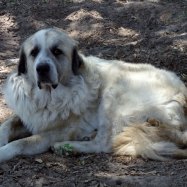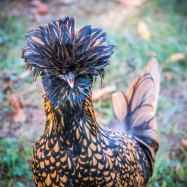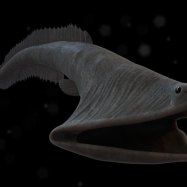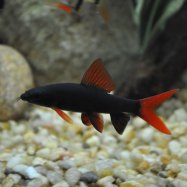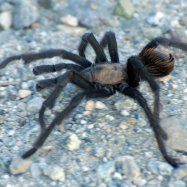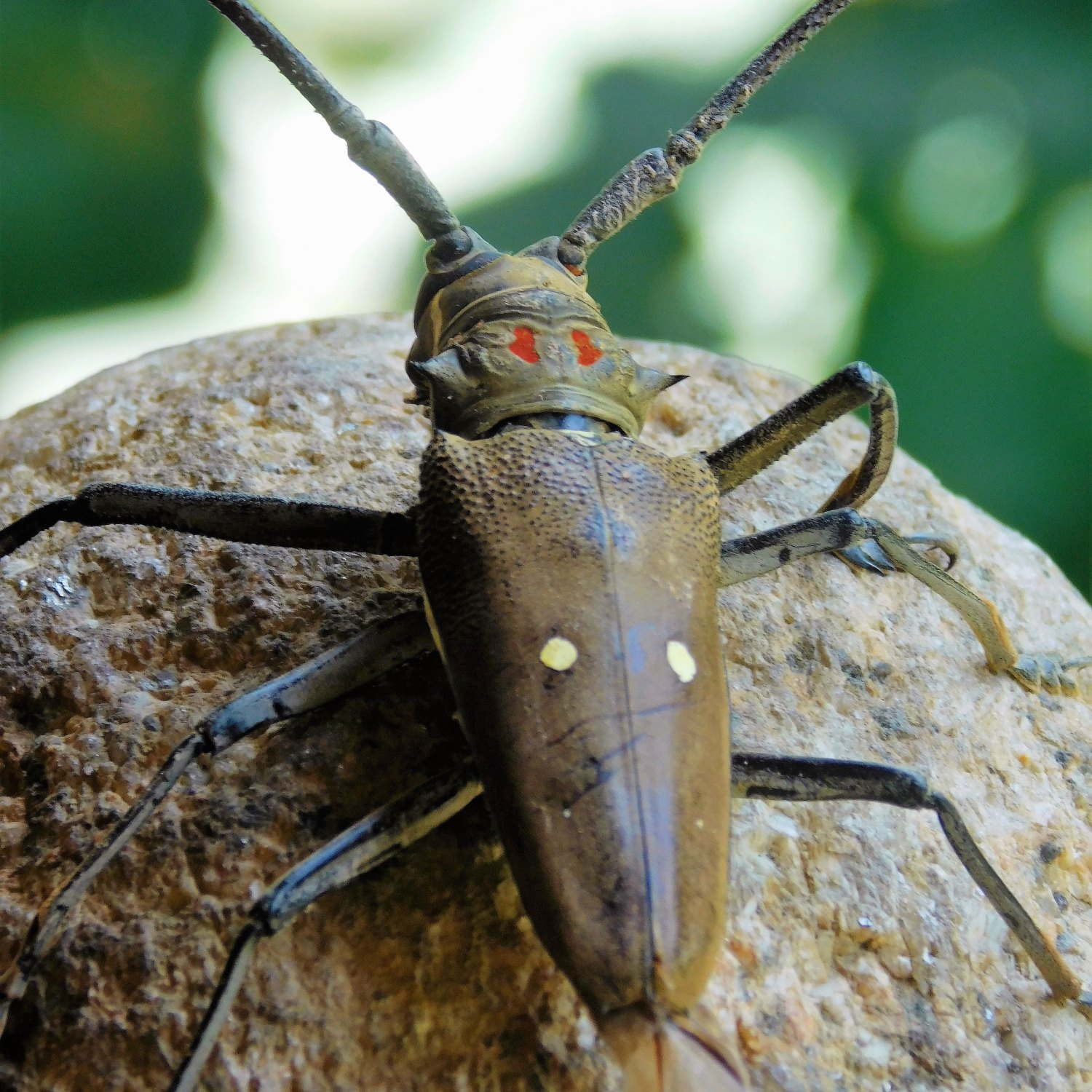
Horned Beetle
1.5 to 2.5 inches
The Horned Beetle, commonly found in the Eastern United States, is a large and robust insect with a length of 1.5 to 2.5 inches. Belonging to the family Scarabaeidae, it is known for its distinctive horn-like projection on its head. Despite their intimidating appearance, these beetles are harmless and play an important role in the ecosystem by feeding on decaying matter. Keep an eye out for these fascinating creatures on your next nature walk. #HornedBeetle #EasternUS #Scarabaeidae
Animal Details Summary:
Common Name: Eastern Hercules Beetle
Kingdom: Animalia
Habitat: Forest
The Mighty Eastern Hercules Beetle: A Fascinating Inhabitant of Eastern United States
In the lush forests of the Eastern United States, an amazing creature roams the forests- the Eastern Hercules Beetle, scientifically known as Dynastes tityus. With its impressive horns and robust body, this beetle is a sight to behold.Classification and Physical Characteristics
Belonging to the Kingdom Animalia and the Phylum Arthropoda, the Eastern Hercules Beetle is an insect of the Class Insecta and the Order Coleoptera. Its family is Scarabaeidae, which encompasses other common beetle species such as dung beetles and June bugs Horned Beetle.The most striking feature of the Eastern Hercules Beetle is its large and robust body shape. It can grow up to an impressive 1.5 to 2.5 inches in length, making it one of the largest beetle species in the Eastern United States. The beetle gets its name from the Greek mythical hero, Hercules, because of its impressive size and strength.
The body of the Eastern Hercules Beetle is predominantly black, with a glossy appearance. This dark coloration serves as a camouflage in its forest habitat, allowing it to blend in with the shadows of the trees and the dark forest floor.
Habitat and Distribution
The Eastern Hercules Beetle is native to the Eastern United States, primarily in the Appalachian and Ozark Mountains. These beetles prefer to inhabit moist deciduous forests, where they can find a steady supply of their preferred food source Havamalt.In the Eastern United States, the beetle can be mainly found in states such as Alabama, Arkansas, Georgia, Kentucky, Mississippi, Ohio, and West Virginia. However, they have also been spotted in other parts of the country, including in some parts of Texas and even as far north as New York.
Within their habitat, these beetles can be found on the forest floor, usually near decaying logs or stumps, where they lay their eggs. They are most active at night, which is when they forage for food and mate.
Feeding Behavior
As herbivorous insects, the Eastern Hercules Beetle has a strict plant-based diet. They feed primarily on decaying plant matter, such as rotting logs, stumps, and leaf litter. They also occasionally consume living plants, though they mostly stick to the decaying ones.These beetles are known to use their strong mandibles to chew through tough plant fibers, making it easier for them to consume their food. They also have a specialized digestive system, with bacteria and other microbes aiding in the digestion of plant matter.
Behavior and Life Cycle
One of the most interesting behaviors of the Eastern Hercules Beetle is its ability to produce loud sounds by rubbing its legs against its abdomen. This aggressive behavior is usually a defense mechanism, aimed at deterring potential predators.The life cycle of the Eastern Hercules Beetle is quite fascinating. Like most beetle species, they go through a complete metamorphosis, which consists of four stages – egg, larva, pupa, and adult.
The female beetle lays her eggs in rotting logs or stumps, which hatch into larvae after a few weeks. The larvae, also known as grubs, spend most of their developmental stage feeding on the decaying plant matter. They can reach up to three inches in length and take up to three years to mature into adults.
Once they have completed their development, the larvae pupate, and about a month later, they emerge as adult beetles. The adult stage of the Eastern Hercules Beetle usually lasts only a few weeks or months, during which they mate and lay their eggs, continuing the cycle.
Role in the Ecosystem
The Eastern Hercules Beetle plays an essential role in the ecosystem as a decomposer. By feeding on decaying logs and stumps, they contribute to the breakdown of organic material, helping to maintain the balance of nutrients in the forest.In their adult life stage, they also act as pollinators, aiding in the reproduction of various plant species in their habitat. Their loud sounds may also help to disperse seeds and attract potential mates.
Threats and Conservation
The Eastern Hercules Beetle is not considered an endangered species, but like many other insect species, they are facing a decline in their population numbers due to habitat loss. Deforestation and urbanization have significantly impacted their natural habitats, leading to a decline in their population.Additionally, pollution and the use of pesticides in agriculture can also harm these beetles as they are sensitive to changes in their environment. It is crucial to protect their natural habitats and create awareness about the importance of these fascinating creatures in the ecosystem.
Intriguing Facts
- The Eastern Hercules Beetle is one of the largest beetle species in the Eastern United States, but it is dwarfed by its cousin, the Goliath Beetle, found in Africa, which can grow up to 4 inches in length.- Male Eastern Hercules Beetles have two large horns on their heads, while females have smaller, less prominent horns.
- The larvae of the Eastern Hercules Beetle can weigh up to 100 times more than the adult beetle.
- These beetles have been used as a food source in some parts of Asia, where they are considered a delicacy.
In Conclusion
The Eastern Hercules Beetle is a fascinating creature that is worth learning more about. From its impressive size and strength to its important role in the ecosystem, these beetles have several unique characteristics that make them stand out in the insect world.While the Eastern Hercules Beetle may not be an endangered species, it is essential to protect their natural habitats and create awareness about these incredible creatures. We must appreciate and care for all animals, no matter their size or appearance, as they all play a vital role in maintaining a healthy ecosystem.

Horned Beetle
Animal Details Horned Beetle - Scientific Name: Dynastes tityus
- Category: Animals H
- Scientific Name: Dynastes tityus
- Common Name: Eastern Hercules Beetle
- Kingdom: Animalia
- Phylum: Arthropoda
- Class: Insecta
- Order: Coleoptera
- Family: Scarabaeidae
- Habitat: Forest
- Feeding Method: Herbivorous
- Geographical Distribution: Eastern United States
- Country of Origin: United States
- Location: Eastern United States
- Animal Coloration: Black
- Body Shape: Large and robust
- Length: 1.5 to 2.5 inches
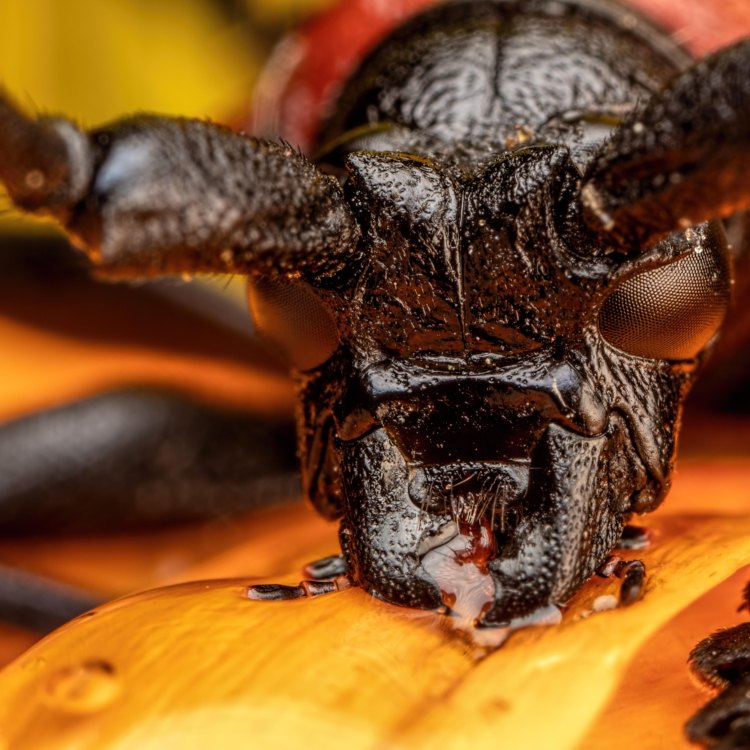
Eastern Hercules Beetle
- Adult Size: Up to 2.5 inches
- Average Lifespan: 1 to 2 years
- Reproduction: Sexual
- Reproductive Behavior: Males fight for females and use their horns to flip rival males
- Sound or Call: No specific sound or call
- Migration Pattern: Non-migratory
- Social Groups: Solitary
- Behavior: Nocturnal
- Threats: Habitat loss and fragmentation
- Conservation Status: Not evaluated
- Impact on Ecosystem: Plays a role in nutrient recycling
- Human Use: None
- Distinctive Features: Large horns on males
- Interesting Facts: The horned beetles are one of the largest beetles in North America
- Predator: Birds, rodents, and other insect predators
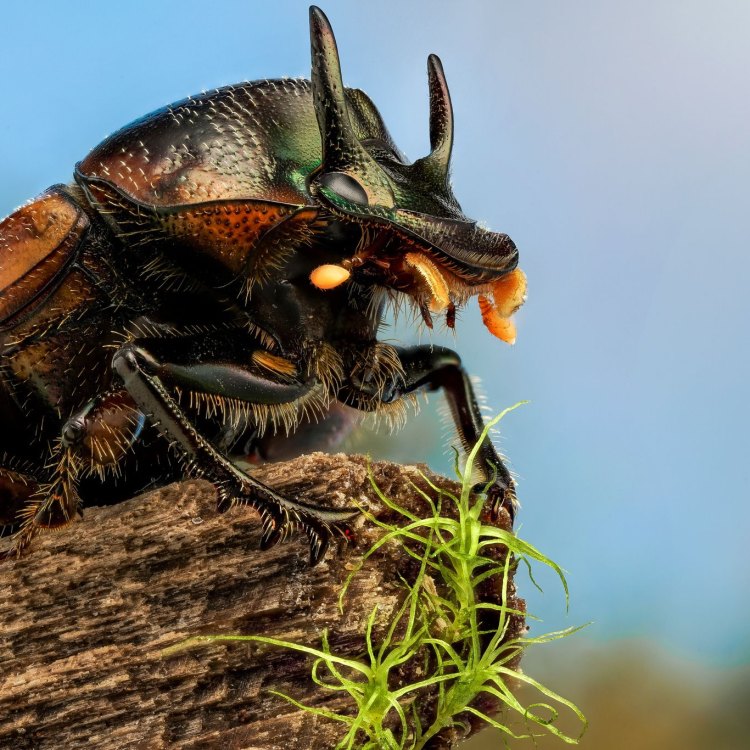
Dynastes tityus
The Mighty Horned Beetle: A Fascinating Creature with Unique Features
In the world of insects, there is a wide array of fascinating creatures that have unique features that set them apart from the rest. One of these remarkable creatures is the horned beetle, a member of the insect family Scarabaeidae. Also known as rhinoceros beetles, these beetles are distinguishable by their large horns, making them an intriguing sight to behold. Let's dive deeper into the world of the horned beetle and discover what makes them one of the most captivating insects in North America PeaceOfAnimals.Com.An Impressive Size and Lifespan
The horned beetle's most prominent characteristic is its size. These beetles can reach a jaw-dropping length of up to 2.5 inches when fully grown. Their impressive size is due to their strong exoskeleton, which is made up of a hard, protective layer called chitin. This armor-like exoskeleton enables them to withstand strong forces and protects them from potential predators.Despite their large size, the lifespan of horned beetles is relatively short, lasting only from one to two years. However, during this time, they can go through a complete metamorphosis, starting as an egg, then transitioning to a larva, pupa, and finally emerging as an adult beetle. The larvae of horned beetles are called grubs, which can live for several years before eventually transforming into adults.
Reproduction: The Battle of the Horns
As with many insects, horned beetles reproduce sexually Hairy Footed Flower Bee. However, their reproductive behavior is quite unique and fascinating. Males will often fight for females, using their horns to flip rival males and claim mating rights. This mating ritual can sometimes result in fierce, horn-to-horn battles between male beetles.Interestingly, the size and strength of a male's horns play a significant role in their success in these battles. The larger and stronger the horns, the more likely the male will be able to overpower its rivals and secure a mate. This is why male horned beetles have evolved to have larger and more elaborate horns than females, making them a formidable opponent in the mating game.
No Sound, But Plenty of Action
Unlike other insects, the horned beetle does not make any specific sound or call to communicate. Instead, they rely on body language and physical interactions to communicate with one another. As mentioned earlier, males will use their horns to signal their dominance and assert their place in the hierarchy.Aside from their horn battles, horned beetles are also known for their impressive strength. They can lift objects up to 850 times their weight, making them one of the strongest creatures in the insect world. They use this strength to dig tunnels in the soil to build their homes and find food.
Nocturnal and Solitary Creatures
Horned beetles are primarily solitary creatures, preferring to live alone rather than in large social groups. They are also nocturnal, meaning they are most active at night. This behavior is crucial to their survival as it allows them to avoid potential predators and hunt for food while most other animals are sleeping.During the day, they will often burrow into the ground or hide under leaf litter to protect themselves from the scorching sun. This behavior also helps them conserve energy and stay cool, as they are unable to regulate their body temperature.
A Threatened Species: Loss of Habitat and Fragmentation
Unfortunately, like many other creatures in the animal kingdom, horned beetles are facing a decline in population due to habitat loss and fragmentation. As human development continues to encroach upon their natural habitat, these beetles are losing their homes, food sources, and mating grounds.Horned beetles are also sensitive to changes in their environment, making them vulnerable to the effects of climate change. Changes in temperature and precipitation patterns, along with droughts and flooding, can have a significant impact on their survival and reproductive success.
Conservation Status and Impact on Ecosystem
At this time, the conservation status of horned beetles has not been evaluated. However, it is essential to understand the role they play in their ecosystem. As scavengers, horned beetles play a vital role in nutrient recycling. They help break down dead plant matter, releasing essential nutrients back into the soil and aiding in the growth of new plants.They also serve as prey for several animals, including birds, rodents, and other insect predators, making them a crucial part of the food chain. The decline in their population could have significant consequences on their ecosystem's balance and overall health.
Human Use and the Fascination with Horned Beetles
Despite their size and impressive features, humans have not exploited horned beetles for any specific use. They are not considered pests and do not cause any significant harm to crops or structures. However, there is a growing fascination with horned beetles, and some people keep them as pets or collect them for their unique appearance.Scientists and entomologists are also interested in studying these creatures to gain a better understanding of their behavior and ecology. These studies can help us develop conservation strategies and preserve these magnificent creatures for future generations to appreciate and admire.
Interesting Facts: Did You Know?
- Horned beetles are one of the largest species of beetles in North America.- Some species of horned beetles have a defense mechanism that involves spraying a foul-smelling chemical as a defense against predators.
- The largest species of horned beetle can be found in Indonesia, reaching up to 6.5 inches in length.
- Horned beetles are sometimes referred to as unicorn beetles because of their large, singular horn.
- The rhinoceros beetle, named for its resemblance to a rhino, is a type of horned beetle common in Japan and other Asian countries.
In Conclusion
The horned beetle is undoubtedly a fascinating creature with unique features that make it stand out in the insect world. From their impressive size and strength to their intriguing reproductive behavior and role in the ecosystem, there is much to learn and appreciate about these beetles.However, as with many other species, their existence is threatened by human activities and climate change. It is vital that we continue to study and understand these creatures to develop effective conservation strategies and protect them for generations to come. The horned beetle may seem small, but its impact on the ecosystem is significant, making it a valuable and important part of our natural world.
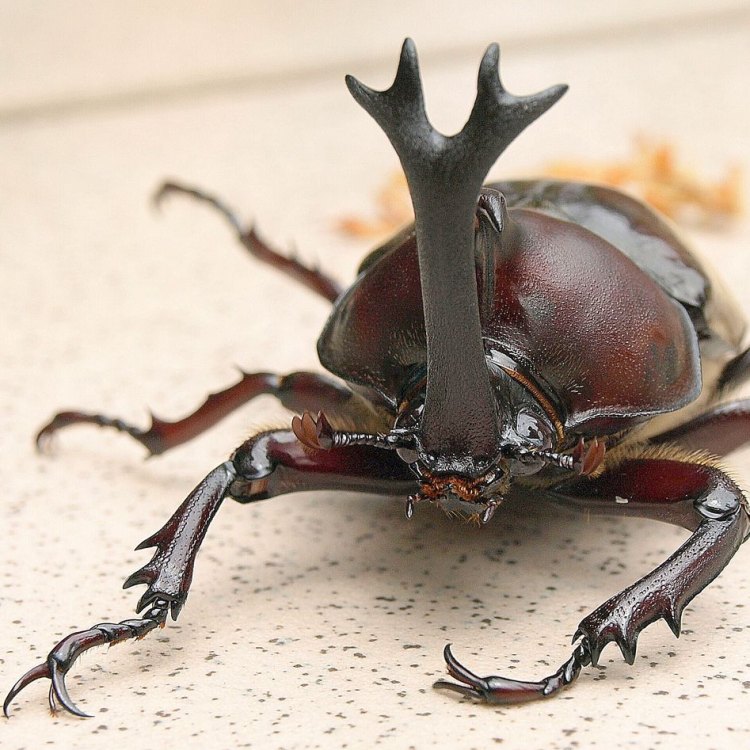
The Mighty Eastern Hercules Beetle: A Fascinating Inhabitant of Eastern United States
Disclaimer: The content provided is for informational purposes only. We cannot guarantee the accuracy of the information on this page 100%. All information provided here may change without prior notice.



